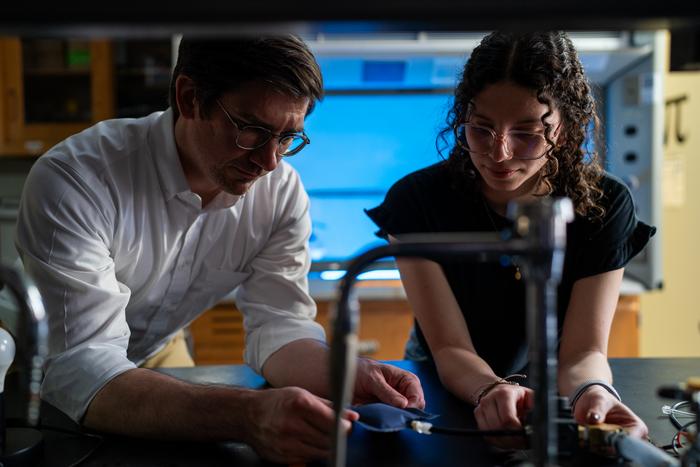
In recent developments at Rice University, researchers at the George R. Brown School of Engineering are pushing the boundaries of soft robotics and wearable technology through their innovative approaches to sheet-based fluidic devices. These novel systems are redefining what it means to create lightweight, flexible, and multifunctional technologies. By changing the narrative around device failure, these engineers are showing that rather than being a limitation, failure can be engineered for enhanced functionality. At the core of their research is the idea of programmed failure, which they have effectively harnessed to improve the resilience of these devices.
The principle behind their work is revolutionary: rather than avoiding or minimizing failure, the engineers are deliberately designing components that are meant to fail in a controlled and predictable manner. “By embracing failure as a functional aspect of design, we can create systems that are smarter and more adaptive,” said Daniel J. Preston, the lead researcher and assistant professor of mechanical engineering. This innovative approach allows for the possibility of devices that are both more resilient and capable of performing multiple tasks with a single control input, significantly simplifying the user experience.
In the study featured in the journal Cell Reports Physical Science, the researchers provided detailed insights into how these heat-sealable, sheet-based fluidic devices operate under pressure. By studying how these devices respond to pressure surges, they were able to revolutionize the design of robust fluidic networks that can maintain operational integrity even when faced with challenging conditions. The team developed a thorough understanding of how internal pressures affect the performance of these components, leading to new designs that prioritize recovery from adverse conditions.
Key to their research was the exploration of adhesion between textile sheets, which are crucial for maintaining the integrity of fluidic networks under varying pressures. The research team utilized an extensive series of adhesive and burst tests to evaluate how well these materials performed when subjected to extreme conditions. Their findings revealed three distinct failure regimes that depend on how the materials are bonded during manufacturing. This level of detail provides a framework for other engineers to follow, supporting the creation of more reliable and efficient fluidic systems.
What resulted from this extensive research was the invention of a “fluidic fuse.” This component was engineered specifically to accommodate pressure changes and designed to fail in a way that protects the entire system from catastrophic damage. Similar to an electrical fuse that breaks the circuit to prevent overload, the fluidic fuse “blows” when a predetermined pressure threshold is reached. This clever solution not only safeguards the device but can also be easily replaced or repaired for reuse, adding an additional layer of sustainability to the technology.
Their findings also opened the door to easily programmable devices that can perform a sequence of actions through a controlled failure process. This allows for complex operational capabilities that would otherwise require numerous control systems or inputs. For instance, in one notable experiment, researchers demonstrated a device that could unscrew a light bulb and then remove it from its socket, all activated through a single pressure-induced command. This potential for dynamic reconfiguration could significantly impact the future design of robots and wearable technologies.
The implications of this research extend well beyond the laboratory. The versatility of these fluidic devices suggests a promising future in various real-world applications, including wearable technology and adaptive robotics. In the realm of rehabilitation, for example, integrating fluidic networks into clothing could provide patients with the support they need while facilitating movement and recovery. Similarly, people with mobility issues could benefit from these innovative systems, as the technology adapts to their conditions in real time, effectively catering to individual needs.
Moreover, there is the potential for these fluidic devices to enhance communication through haptic feedback, further extending their usability in everyday technology. The prospect of creating soft, adaptable robots that can respond to their environments with minimal input simplifies the entire design process. This represents a significant leap in the development of multifunctional autonomous systems, yielding technology that is capable of complex tasks without the clutter of intricate electronic control systems.
The research team believes that their innovative approach to engineering failure can dictate a new pathway for material science and engineering disciplines alike. By leveraging the potential for failure and utilizing it as a tool for advancement, they propose a paradigm shift in how engineers and designers approach challenges in creating sophisticated systems. Daniel J. Preston and his team aim to not just strengthen existing technologies but also to inspire future innovations.
As this research progresses, it will be crucial to watch for new developments in how these insights translate into practical applications. The balance between failure and functionality is delicate, but with careful engineering and an embrace of failure, the possibilities are endless. Both the fields of soft robotics and wearable technology stand to gain significantly from this intelligent evolutionary leap in design.
In conclusion, the work conducted by Rice University’s team marks a significant advance in engineering, where failure is no longer viewed merely as a hurdle to overcome but as a potential asset that can yield incredible technological developments. As researchers continue to unravel the complexities of sheet-based fluidic systems, we stand on the brink of a new era in how we construct and interact with technology.
Subject of Research: Programmable failure in heat-sealable sheet-based fluidic devices
Article Title: Programmable failure in heat-sealable sheet-based fluidic devices
News Publication Date: February 11, 2025
Web References: Rice University News
References: Cell Reports Physical Science
Image Credits: Brandon Martin/Rice University
Keywords
Wearable devices
Mechanical systems
Adaptive control
Textile engineering
Soft robotics
Tags: advanced wearable technologyembracing failure for enhanced functionalityengineering resilience in technologyGeorge R. Brown School of Engineering researchlightweight flexible technology solutionsmultifunctional fluidic devicesnovel approaches to wearable devicesprogrammed failure in device designRice University engineering breakthroughssmart adaptive systems in roboticssoft robotics innovationsuser-friendly technology advancements





